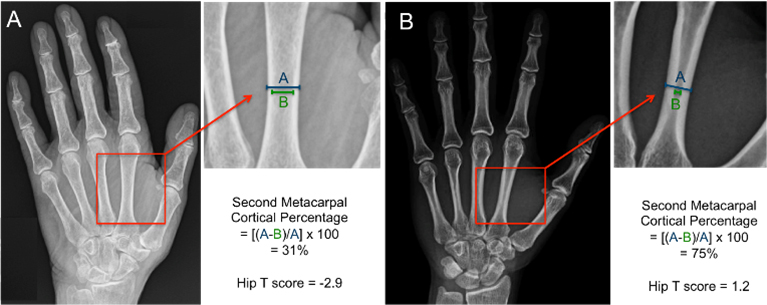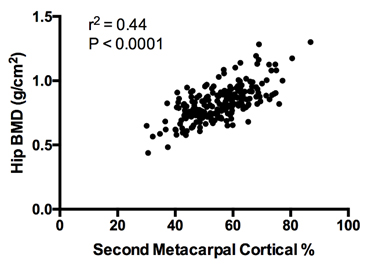Back to 2017 Annual Meeting Program
Simple Assessment of Global Bone Density and Osteoporosis Screening Utilizing Standard Radiographs of the Hand
Joseph J. Schreiber, MD; Robin N Kamal, MD; Jeffrey Yao, MD
Stanford University Medical Center, Redwood City, CA
Background: Osteoporosis and resultant fragility fractures have vast consequences at both the individual level and to the overall health care system. Screening rates remain low, and our current system tends to be more reactive than preventative. While dual-energy x-ray absorptiometry (DXA) is the gold standard for assessing bone mineral density (BMD), other simpler tools may be able to provisionally screen bone quality and signal the need for intervention. We hypothesized that the second metacarpal cortical percentage (2MCP) that is calculated from standard radiographs of the hand or wrist would correlate with hip BMD derived from DXA, and could provide a novel simple screening tool for osteoporosis.
Methods: 200 consecutive patients who had hand or wrist radiographs and hip DXA scans within one year of another were included in this retrospective diagnostic series. Mid-diaphyseal 2MCP was calculated as a ratio of the cortical diameter to the total diameter (Figure 1). The correlation between 2MCP and total hip BMD was assessed. Subjects were stratified into normal, osteopenic, and osteoporotic cohorts based on hip t-scores, and thresholds were identified to optimize screening sensitivity and specificity.
Results: Second metacarpal cortical percentage (2MCP) correlated significantly with BMD and t-scores from the hip (Figure 2, r2 = 0.44, P<0.001). A 2MCP threshold of < 60% optimized sensitivity (88%) and specificity (60%) for discerning osteopenic subjects from normal subjects, whereas a threshold of < 50% optimized sensitivity (100%) and specificity (91%) for differentiating osteoporotic from normal subjects.
Conclusions: By demonstrating that global BMD may be assessed from 2MCP, our data suggests that radiographs of the hand and wrist can play a roll in accurately screening for osteopenia and osteoporosis. This simple screening tool that is already ubiquitously utilized for patients with hand or wrist problems may help identify patients at risk for fragility fractures. This would thereby prompt additional studies, appropriate referral, or initiation of treatment. Routine use could be valuable for decreasing morbidity on an individual level and improving financial efficiency on a systems level.
Back to 2017 Annual Meeting Program
